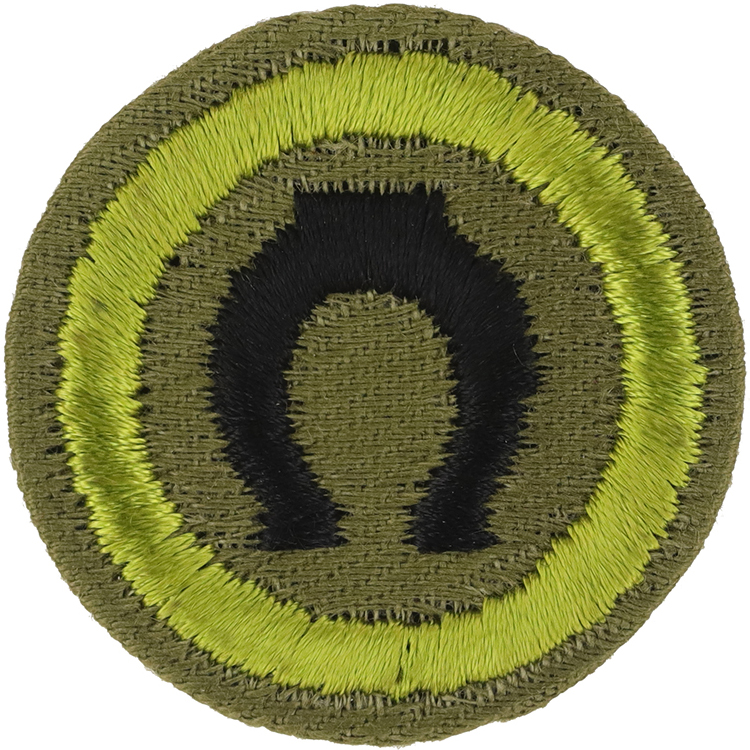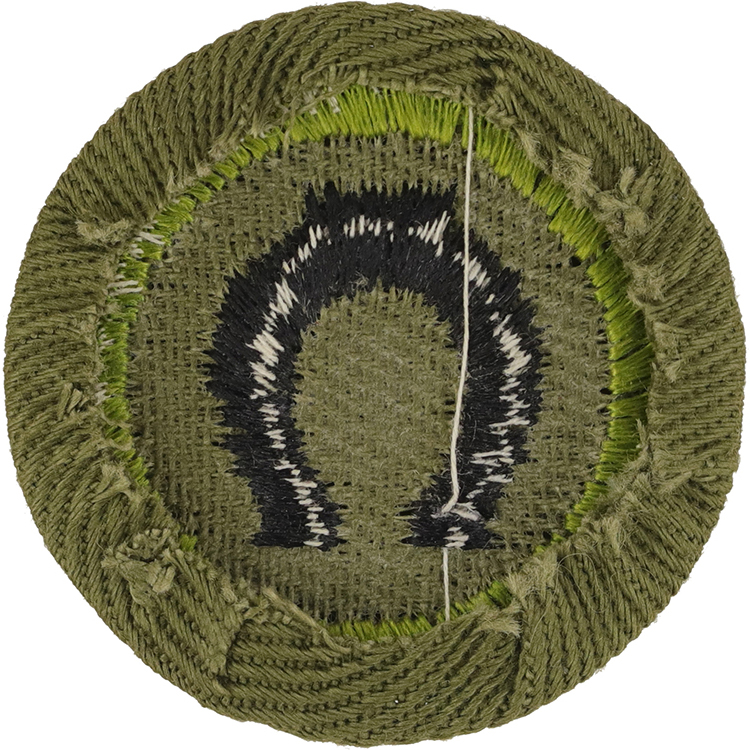
Fig. 1: Horsem-E2-Front
- Cloth: Khaki right twill
- Embroidery: Cotton lock stitch

Fig. 2: Horsem-E2-Reverse
- Back: Plain NO imprint with starch
Item Name: Horsemanship 1947 - 1960
Item ID: Horsem-E2
Collector Rating: 1
Requirements January 1938, until June 1948
To obtain a Merit Badge for Horsemanship a Scout must meet any seven of the following requirements:
1. In presence of Counselor-
(a) Harness a horse OR
(b) Saddle and bridle a horse, point out and explain use of five important parts of both saddle and bridle.
2. In presence of Counselor-
Ride a horse at a walk, trot and one other gait, mounting and dismounting correctly.
3. Explain symptoms of colic, distemper, and four other common horse diseases.
4. Explain how to detect defects of the legs and feet of a horse, such as ringbone, spavin, shoe boil and splint.
5. Give at least six practical suggestions for management and treatment of a pair of draft horses on hot summer work days, and give practical directions for watering and bedding of horses after a trip or day's work.
6. Give best feed rations for draft horses when at work in hot weather and when idle in cold weather, explaining why change of feed is necessary.
7. Name four leading breeds of horses and explain fully for what each breed is noted.
8. Show how to clean, oil, and treat bridle, saddle or harness to keep leather in good all-weather condition.
9. Show how to approach horse in stall in case of fire and how to remove him safely from stall and barn.
10. Show how to manage a horse and handle front and rear legs while being shod.
OR
Meet the season or year-round requirements of a 4-H Club project or agricultural home project in Horsemanship as programmed by the state, county and local leaders. This may involve membership in a Colt Club or carrying out an actual project in Horsemanship for a whole year under leadership.
Requirements June 1948 until January 1957
Meet any seven of the following requirements:
1. In presence of Counselor-
(a) Harness a horse, OR (b) saddle and bridle a horse, point out and explain use of five important parts of both saddle and bridle.
2. In presence of Counselor-
Ride a horse at a walk, trot and one other gait, mounting and dismounting correctly.
3. Explain symptoms of colic, distemper, and four other common horse diseases.
4. Explain how to detect defects of the legs and feet of a horse, such as ringbone, spavin, shoe boil and splint.
5. Give at least six practical suggestions for management and treatment of a pair of draft horses on hot summer work days, and give practical directions for watering and bedding of horses after a trip or day's work.
6. Give best feed rations for draft horses when at work in hot weather and when idle in cold weather, explaining why change of feed is necessary.
7. Name four leading breeds of horses and explain fully for what each breed is noted.
8. Show how to clean, oil, and treat bridle, saddle or harness to keep leather in good all-weather condition.
9. Show how to approach horse in stall in case of fire and how to remove him safely from stall and barn.
10. Show how to manage a horse and handle front and rear legs while being shod.
OR
Comply with the 4-H Club or Home Project Requirements in Horsemanship.
Requirements January 1957 until September 1958
Meet any seven of the following requirements:
1. In presence of counselor- (a) Harness a horse, or (b) bridle and saddle a horse, point out and explain use of five important parts of both bridle and saddle.
2. In presence of Counselor- Ride a horse at a walk, trot and one other gait, mounting and dismounting correctly.
3. Explain symptoms of colic, distemper, and four other common horse diseases.
4. Explain how to detect defects of the legs and feet of a horse, such as ringbone, spavin, shoe boil and splint.
5. Give at least six practical suggestions for management and treatment of a pair of draft horses on hot summer work days, and give practical directions for watering and bedding of horses after a trip or day's work.
6. Give best feed rations for draft horses when at work in hot weather and when idle in cold weather, explaining why change of feed is necessary.
7. Name four leading breeds of horses and explain fully for what each breed is noted.
8. Show how to clean, oil, and treat bridle, saddle or harness to keep leather in good all-weather condition.
9. Show how to approach horse in stall in case of fire and how to remove him safely from stall and barn.
10. Show how to manage a horse and handle front and rear legs while being shod.
*As a 4-H'er, complete a club project in this subject. Or as an FFA member, meet these or equivalent requirements through the FFA supervised farming program
Requirements September 1958 until September 1967
1. Demonstrate ability to lead a horse from a stall, corral or field, and saddle and bridle properly.
2. On level ground continuously execute the following movements correctly, at ease and in sympathy with the horse:
(a) Mount. (b) Walk horse in a straight line for at least 60 feet. (c) Make half circle of not over 16 feet in radius at walk. (d) Trot in a straight line for at least 60 feet. (e) Make a half circle at trot of not over 20 feet. (f) Canter in a large circle 20 feet or over in radius on proper lead. (g) Change direction either by reversing at canter and changing leads or coming down to a walk reversing and taking up canter on proper lead. (h) Halt straight. (I) Back up straight four paces. (j) Halt and dismount.
3. Demonstrate ability to properly groom, pick out feet, and generally care for horse after riding.
4. Describe the symptoms of colic and four other common horse diseases.
5. Explain three principal defects of feet or legs and explain how to detect.
6. Describe the correct method of feeding the horse that you use for this test. Explain wy the amount and type of feed will vary according to the work the horse does and the type of horse he is.
7. Demonstrate the proper care of saddle and bridle and name the principal parts of the saddle and bridle.
8. Name at least fifteen principal points of a horse.
9. Name four leading breeds of horses and explain fully for what each breed is noted.
10. Show how to safely approach and remove a horse from a stall in case of fire.



